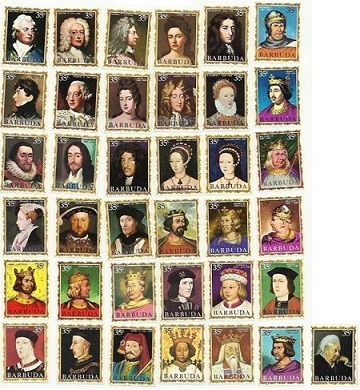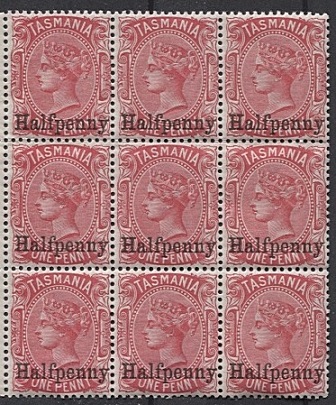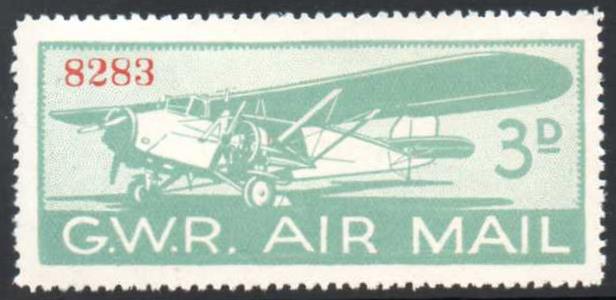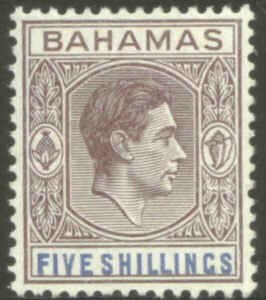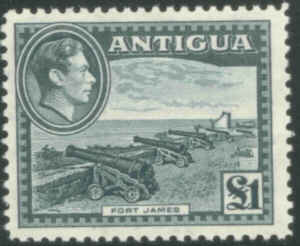9th December 2014 - Christmas Social and Seasonal Displays
The final meeting of 2014 produced a good turnout and a splendid buffet. There was considerable variety in the Christmas-related material displayed by members.
Alan Kane showed Christmas Post & Go stamps (including the receipt for them).
Michael Curling showed Christmas cards in the form of postcards from India and New South Wales, Slovenia booklets with a seasonal theme,
and a photocopy of a collectible Huntley & Palmer biscuit tin.
Trevor Cornford displayed material relating to a Georgian Christmas in Ceylon, a brochure for Reid’s Hotel in Madeira with a menu signed by Ernest Shackleton and details of excursions, and details of the New English Hotel (tariff 16/- per day) also in Madeira.
Chris Wootton posed a puzzle with the photograph shown below - correctly identified by the Hon. Secretary as a view over the Tessellated Pavement towards Pirates Bay in Tasmania.

This was followed by a range of stamps from many countries, including some Christmas stamps.
Alwyn Lowe showed postcards sent as Christmas cards from a range of countries, including Belgium, France, the UK, Denmark, Finland, Sweden. He ended with some 1954 Danish Charity Seals.
Finally, Mark Bailey showed a range of postcards from the Channel Islands with Christmas and New Year greetings. These included a card taxed because it was personalised by writing a message in glue and then applying glitter. The Post Office in the UK, followed by other Post Offices around the Commonwealth, banned this type of card in 1907-1908. Although considered by many people as delightful confections of colour and tinsel, with large sale in picture postcard shops, cards of this type were found by the postal authorities to be engines of destruction. The glitter was composed of emery powder and powdered glass, and it adhered only loosely to the cards, so that when they were being hurried though the mailroom in the process of
date-marking and sorting, they left behind a small cloud of sharp, cutting dust. This dust found its way into the lungs, throats and nostrils of the unfortunate postal employees and could set up an irritation that was frequently a forerunner of serious pulmonary trouble. With the use of the date-marking machine, the flying powders were carried into the working parts of the machine, where they soon caused grooves and erosion which interfered with the working of the machine, and entailed recurring repairs. In these circumstances tinsel glitter postcards were prohibited in the United Kingdom and New Zealand, and similar action was taken in the Commonwealth. These cards, if enclosed in envelopes, could be transmitted through the post, but not otherwise.
Those present then enjoyed the buffet, which was organised by Alwyn Lowe and Ian and Marianne Murray, and an opportunity to socialise.
Fellowship of the Royal Philatelic Society London
|
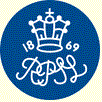
|
Congratulations to two members of the Wokingham & District Philatelic Society, Malcolm Ray-Smith and Mark Bailey, who were elected as Fellows of the Royal Philatelic Society London on 13th November 2014.
|
11th November 2014 - Cayman Islands - James Podger
Captain D. James Podger is a Fellow of the Royal Philatelic Society London, a member of the British West Indies Study Circle and a member of the Indian Ocean Study Circle. James entertained the meeting with a splendid display of Cayman Islands, presented with knowledge and humour.
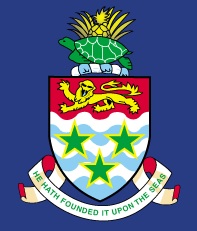
The motto of the Islands is "He hath founded it upon the Seas". On 10th May 1503 a chance wind blew Christopher Columbus' ship off course. He was thrust westward toward "two very small and low islands, full of tortoises (turtles), as was all the sea all about, insomuch that they looked like little rocks." He called these islands ‘Las Tortugas’ after the thousands of turtles on shore.
The two islands sighted were Cayman Brac and Little Cayman. In 1523, a map was drawn showing all three islands (Grand Cayman, Cayman Brac and Little Cayman) under the name ‘Lagartos’ meaning alligators or large lizards. By 1530, the islands were called the ‘Caimanas’, derived from the Carib Indian word for the marine crocodile that formerly inhabited the islands. ‘Caimanas’ evolved to the name Cayman Islands. The display was introduced with maps showing the Cayman Islands' layout and position in the Caribbean.
In the early days, only pirates and their like lived on the Islands, but when they were eventually properly settled, they were governed from Jamaica. The Governor denied them a mail service as they were not on the regular trade routes, however eventually in 1889 they were allowed stamps from Jamaica.
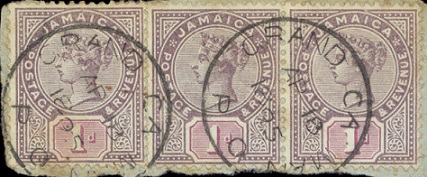
The Cayman Islands were sent their own ½d and 1d stamps that arrived in November 1900, were taken back to Jamaica and only returned to the Caymans in February 1901.

On the death of Queen Victoria, King Edward VII stamps were requested and this time they were allowed values up to 1/-. Keyplate sets were issued in 1902 and 1905 and are relatively straightforward, but finding correct single use on cover is quite difficult.
The Post Offices on Grand Cayman were at Georgetown with a rural office at East End, and on Cayman Brac, and we were shown a cover cancelled at East End.

In 1907, new values were issued up to 5/-, but the colony ran out of ½d stamps, so ½d on 1d surcharges were prepared in Jamaica. However, these supplies also ran out and the Postmistress surcharged the 5/- stamps with either ½d or 1d. Forgeries of these surcharges exist. We were shown examples of both surcharges, including use on cover.
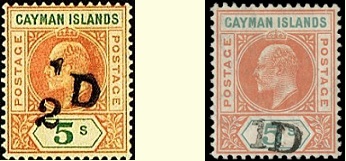
The next section showed the 'Glover' flaw (a dip in the frame) that occurs on keyplates issued to the Cayman Islands, Gambia and the Seychelles, followed by examples of the 'Slotted Frame' flaw that occurs on stamps of the same three colonies and St Helena.


A new set was issued over 1907-1909 inscribed Postage and Revenue with values to 10/-. James showed examples from the Imperium sheets. The colony again ran out of stamps for the foreign rate, and four sheets of 120 of a provisional 2½d on 4d surcharge were prepared and brought into use on 12th February 1908. A 1d on 4d surcharge was prepared for Revenue use, but a few seem to have escaped into the post!

½d was the internal postage rate and we were shown examples as well as use of the 1d postcard rate, including a card from the Commissioner. The first half concluded with 'Schooner mail' to the USA and Canada and covers with all issued values.
The second half opened with catalogues of the Watkin and Meredith sales, which form a definitive source of what is available to collect, although these can be supplemented by the (later) sale catalogues featuring the Graham Booth and John Byl Cayman Islands collections.
James showed an exposition of the 'Spaven' flaw (a downward bulge in the name tablet). This occurs on the stamps of many colonies as well as the Cayman Islands, and he showed a £25 Straits Settlements stamp with the flaw.
In 1908 a ¼d stamp was issued for postcards and local unsealed letters. This stamp quickly ran out because of large orders from dealers to make up cheap packets. We were shown use on a 4½d cover to the USA (the only recorded use to overseas) and a number of other covers and pieces with multiples. These were followed by manuscript provisionals (surcharging was not allowed) for two short periods in 1908 when stamps had run out.

A small ¼d postcard was prepared for internal use, and a 1d stationery envelope for the Empire rate. Ex-Madagascar Specimens and various usages were shown, including a taxed card to the UK.
The next section comprised an extensive range of War Tax stamps. The War Tax was only applied to Empire mail and just applied once (not weight-dependent). This section included a number of varieties.
![Cayman Islands War Tax stamps 1½d on 2½d variety missing stop after ‘STAMP’ [R.1/4], SG. 53b. Cayman Islands War Tax stamps 1½d on 2½d variety missing stop after ‘STAMP’ [R.1/4], SG. 53b.](cayman_1917.jpg)
A spectacular item was a long envelope with multiple copies of the ½d on 5/- stamp, also bearing the Commissioner's Seal. King George V stamps were issued up to 10/- value and we were treated to many blocks with Plate Number up to 8 as a stunning finale.

Chairman Brian Pugsley gave the Vote of Thanks and complimented James on the quality and scarcity of the material shown, and the excellent way in which he had described it.
28th October 2014 - British Levant - Tony Stanford
Tony Stanford is a Fellow of the Royal Philatelic Society London, the Secretary of the GB Overprints Society and a member of the Windsor & District Philatelic Society, the Maidenhead & District Philatelic Society and the Amersham & District Philatelic Society. He is an Association of British Philatelic Societies Accredited Federation Judge (in the Thames Valley & District Philatelic Federation) and he has kindly judged our annual competitions for a number of years. We were delighted to have Tony come to our meeting to display British Levant stamps and postal history, covering the period up to the beginning of World War I.
The postal demands of the Crimean War gave rise to the need for a main Post Office away from the field of battle. To meet this need, a Post Office was opened in Constantinople in 1854, represented by an early cover from the Black Sea Fleet via Danzig.


A sketch of the interior of the British Army Post Office in Constantinople
(place pointer over the picture to see the article from page 61 of the Illustrated London News of 19th January 1856)
After the Crimean war, a new Post Office was opened on the Constantinople waterfront. It had a flagpole and a flag would be raised whenever a mail ship was in sight, leading to a frenzy of activity at the Post Office. Constantinople also had French and Austrian post offices.

A 'C' cancellation was used on the GB stamps from the Constantinople office, and there are several variants. The depreciation of the local currency by 1885 led to surcharging of the lower value GB stamps to prevent currency speculation. We were shown a range of these including varieties. On 25th February 1893, while the Postmaster was away, his assistant produced a '40 paras' handstamp and made unofficial overprints.
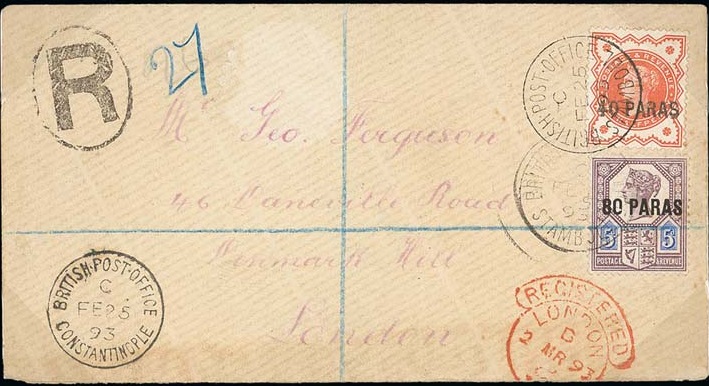
We saw a registered cover without etiquette, as there were none, and a long cover to the USA with a large franking.
Postal Stationery was not overprinted except for the 2½d envelope (the standard UPU overseas rate). Tony displayed a scarce ½d vermillion envelope used for Printed Matter, and some labels and packets used to send trade samples (e.g. dates) at the special sample rate. A parcel cover used unoverprinted stamps; parcels had to be taken to the Post Office and franked there, so that the higher value stamps could not be used for currency speculation.
The display also included the elusive but fascinating stamps produced for local mail services that were provided between 1865 and 1891.
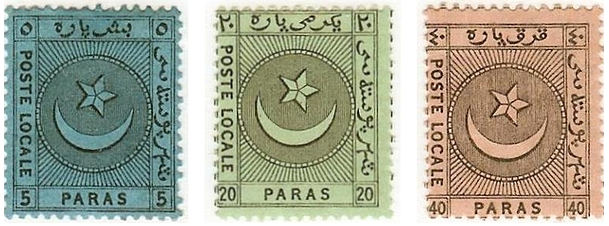


Finally in this first part we were shown mail from some of the other offices in the area, including Smyrna (now Izmir) (1872) with a 1¼d postcard, Beyrout (Beirut) (also 1872), using the cancel G06, and Salonica (1900) using a single ring cancel.

The second part covered the Edwardian and Georgian material up to World War I. The same overprints as used on Victorian stamps were used on Edwardian stamps. These were displayed and some Specimens from the Madagascar archives were included. Postcards remained unoverprinted. Tony also showed some scarce Taxed mail items.
From 1905, higher values were overprinted 'LEVANT' only, and use of the remaining unoverprinted stock after this date is scarce.
Tony showed a front of a high rate Insured Packet with franking of 6 shillings 10½d, equivalent to 33 piastres. Incoming parcels were taxed by Turkish Customs using a British PO form. Tony displayed one of these scarce items.
In 1907 a new rate step of ¾ piastre was introduced, but there were no appropriate stamps until 1909. In the interim, ½d stamps were used as ¼ piastre.
The K88 handstamp was issued, but has not been seen used. However Tony showed us examples of the very scarce K88 Tax Marks.
Wrappers were overprinted by De La Rue and McCorquodale. In 1911 Harrison took over stamp printing from De La Rue. We saw a Harrison print with 'STD' perfin on a copy of the Standard newspaper.
We were shown examples of registration envelopes used for ordinary mail, because they were more secure.
A discovery item shown was a different LEVANT overprint on an Edward VII McCorquodale card. As King Edward VII stamps ran out, overprinted King George V stamps were introduced. Tony's display included multiple overprints, including albinos.
Tony finished his display with a Registered Sample wrapper uprated to Germany. At the outbreak of the war in 1914 the Turkish government abrogated the laws whereby it had given up its rights to operate international posts, and closed all the foreign post offices.
Chairman Brian Pugsley thanked Tony for a comprehensive and fascinating display of unusual material.
14th October 2014 - Kings and Queens
In the absence of Brian Pugsley, Mark Bailey chaired the meeting on the subject of Kings and Queens.
Mark opened proceedings, leading by example with a four-frame display of 80 years of images of Queen Elizabeth II on stamps from 1933 to 2013. This included numerous stamps from Great Britain and across the Commonwealth based on the well-known portraits by Dorothy Wilding, Pietro Annigoni and Arnold Machin as well as many others.


Tom Cope displayed a single page, featuring a numbered series of 37 stamps issued in Barbuda in 1970-71, showing English Kings and Queens.
Patrick Reid completed the first half with overprinted Queen Victoria stamps from Tasmania. These included the ‘al sideways’ variety of the halfpenny overprinted on 1d in a block of 12, a few examples of the 2½d on 9d and a range of the 1½d on 5d, including a ‘confection’ cover with the ‘1’ of the overprint inverted in a pair with a normal example..
At the beginning of the second half, Michael Curling showed a good run of the definitive issues (ex-Kenneth Chapman) featuring King Zog of Albania through to 1939, when Albania was annexed by Italy.

Roger Sammons followed with the series of Kings and Queens from Barbuda again, but this time compared to the similarly themed issue from Umm al-Quwain. It is remarkable that some of the portraits were supposed to be of the same people! Roger completed his display with an issue from Ajman showing French Kings and Queens.

Finally, Eric Holmes returned to Queen Victoria and showed us the plates of the Penny Black, either on or off cover, including plates 10 and 11.

Mark thanked all those who had brought material along to contribute to an enjoyable evening.
Results of the Membership Survey
To conduct a survey of the Society's members, a questionnaire was sent with the 2014-2015 subscription renewal forms. There were 4 multiple-choice questions and 7 open questions seeking members' opinions, intended to allow members to provide feedback on a number of aspects of the Society, to gauge the level of engagement by the members, and to stimulate comment and ideas for the potential improvement of the Society for its members.
The questionnaire was sent to 79 people, some through the post and some via email, and in total 56 responses were received by 1st October 2014, the end date for the survey. The summary statistics for answers to the multiple-choice questions are as follows:
Do you attend the meetings? | |
Often | 23 | | Sometimes | 13 | | Never | 20 |
Do you attend the AGM? | |
Often | 22 | | Sometimes | 7 | | Never | 27 |
Do you receive the packets? | |
Yes | 40 | | | | | No | 16 |
Do you look at the website? | |
Often | 4 | | Sometimes | 32 | | Never | 20 |
Thank you to everyone who responded. There was a high response rate and the opinions expressed revealed that although some 36% of the people who responded do not go to meetings, there is a high level of satisfaction with the programme of meetings amongst the people who do attend them, and some put forward ideas for future meetings. As regards the circulation packets, several members expressed concern about the quality and price of the material in circulation, and some felt that the circuit should be further revised to make it less tortuous. The website, used by a majority of the members who responded, is considered a useful facility that provides information to members. The suggestions and comments made in the responses will be considered by the Committee and any agreed improvements will be made.
The Deputy Chairman, Mark Bailey, has produced a report that documents all the responses and explains the key findings and actions arising from the comments and suggestions that have been received. A copy of the report has been sent to members by email, and if any member would like a double-sided printed copy posted to them, they should write to Mark (his address is on the programme card) enclosing a stamped addressed envelope large enough to take 9 sheets of A4 paper. A number of vendors have requested feedback on the material they sell in the exchange packets, so they will find the report particularly useful.
Results of the Thames Valley Philatelic Federation 2014 16-sheet Competition
The results of the 16-sheet competitions have been announced. Congratulations to Eric Holmes and Derek Steele of the Wokingham & District Philatelic Society.
Postal History Class
1st Eric Holmes - Spanish Handstamps on Mail from Gibraltar to Spain and beyond to 1855.
Awarded 91 marks
Judges' comments: An excellent introduction, and very well presented with nicely balanced sheets.
Aerophilately Class
2nd Derek Steele - Pioneer Airmails within Newfoundland in the 1920s and 1930s
Awarded 85 marks
Judges' comments: A good introductory sheet with a nice story. Nice to see colour scans.
9th September 2014 - Zanzibar - Mel Doyle
Mel Doyle and his wife Sue travelled from Portsmouth to show us their collection of Zanzibar. Mel, who is a member of Portsmouth & District Philatelic Society, the British Society of Australian Philately, the Canadian Philatelic Society of Great Britain, the Irish Study Circle and the Royal Philatelic Society London, explained that he would show us Postal History and Stamps, with nothing after 1964, when there was a revolution in Zanzibar.
Zanzibar is formed of two islands, Zanzibar and Pemba, and lies 25 miles off the coast of East Africa. In general it is very hard to find material.
In 1698 the Arabs of Muscat and Oman, assisted by English ships, captured the Portuguese fort at Mombasa. Gaining control of the whole area, Zanzibar and Pemba fell into their hands. In 1747 Ahmed bin Said el-Busaidi, founder of the Busaidi dynasty, still reigning in Zanzibar, became ruler of Muscat and Oman.
In around 1833 the Sultan of Oman moved to Zanzibar, and from 1842 onwards there was a British Consul. Zanzibar separated politically from Muscat and Oman in 1861. In 1873 the Sultan agreed, by treaty with Britain, to prohibit the export of slaves from East Africa and to close all public slave markets in his dominions.
In 1886 Britain, France and Germany recognized the sovereignty of the Sultan over the islands and a ten-mile wide strip of about 600 miles in length along the mainland coast. In 1887 part of this strip was leased to the British East African Association and administration eventually passed to the Government of Kenya.
Zanzibar and Pemba were placed under British protection by the Sultan in 1890 and a Constitutional Government was established in the following year. Slavery ended in 1892, and from this time, the revenues from slavery were replaced by exports of rubber and ivory.
A post office under Indian administration provided postal services from late 1868 through to early 1869. This was re-opened on 1st October 1875 as a foreign post office having special relations with the Indian Post Office. The use of Indian stamps was obligatory. They can only be detected by their cancellations. Subsequently mail was forwarded via Seychelles or later via Aden or Bombay. The office continued to function until 10th November 1895, the date of transfer from Indian to British East African administration.
The Zanzibar Protectorate post office, administered by the Postmaster-General of British East Africa, operated from 10th November 1895. Supplies of Indian stamps were overprinted with "Zanzibar" at the office of the Zanzibar Gazette. The work having been performed by native craftsmen, there are countless errors. In addition, known forgeries of the overprints exist.

In 1895 Zanzibar joined the Universal Postal Union and this called for a 2½ annas denomination to cover the foreign letter rate. Supplies of the 2½ annas overprinted stamp not being sufficent, stocks of the 1½ annas were surcharged "2½" in red in December 1895.
On 11th May 1896 the 1 anna was similarly surcharged in black, on 15th August the 2 annas was given the surcharge in red and on 15th November the 1½ annas was surcharged in red in a different type. Seven different settings of the "2½" have been catalogued and there are many errors.
We were shown some of the myriad varieties that occur on the local overprints. Apparently some collectors believe these should be ignored, while others feel that they are important.
Between June and August 1896, supplies of British East African stamps were overprinted "Zanzibar". These were necessary because of the delay in the delivery of the first definitive stamps.
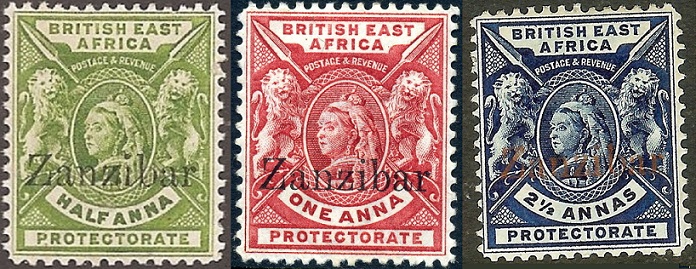
In addition to the Zanzibar post office, there were six other post offices on Zanzibar and three offices on Pemba. A French post office operated from 16th January 1889 to 31st July 1904, and a German postal agency operated from 27th August 1890 to 31st July 1891. Zanzibar took control of its own postal services in 1901.
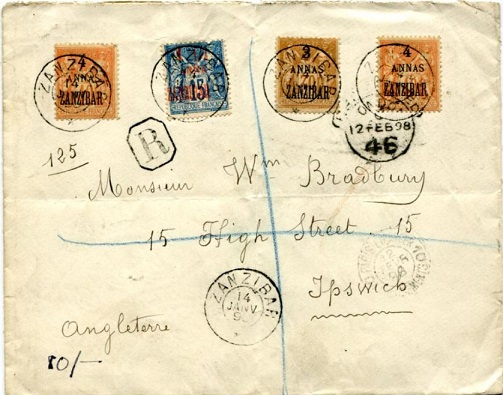
The first section of the display included part of a correspondence from Lieutenant Gerald Walter Russell, Royal Navy, describing a journey to Zanzibar, with covers and cards providing a first hand account of the territory.
The first local definitives were issued in 1896, but the Sultan depicted died before they were issued. There were three different Sultans before 1911, but the next Sultan reigned until the 1940s.
We saw a range of definitives (colloquially called the "Red Flag" issues) produced between 1896 and 1904. These issues suffered from inking problems due to the ink recipe.

The highlight of the material covering the period up to 1927 was a Registered cover. Such covers from this period are very difficult to find unless Official.
The second part covered the reign of Sultan Khalif bin Harub from 1936, when he celebrated his Silver Jubilee. By this time the interests of collectors were being considered and it became possible to obtain sheets with selvedges and marginal markings.
Zanzibar issued a Victory set in 1946 by overprinting definitives, some scenic definitives and a Royal Silver Wedding set in 1948. This last set is the only Zanzibar set bearing a royal image.

In 1964 the Sultan was deposed in a revolution and he was evacuated by the Royal Navy. The existing stamps were overprinted locally 'Jamhuri 1964'. Forgeries of these are also known. The Republic is now subsumed into Tanzania.

Next came a range of Postage Dues, with examples on covers. Only some 40 or so such covers are recorded.

Mel followed these with some good commercial Airmails. Those from the 1931 to 1940 period are difficult to find. The control of Air Services was with Kenya and Tanganyika, and provided by Wilson Airways. Much of the material was philatelic, including some generated by Mr Collins, a Nairobi stamp dealer.

An airmail service to the USA became available in 1940 but was curtailed by World War 2. An air link to Pemba was inaugurated in 1954. Mel finished his display with a Sample Post cover that had been used to send some chillies.
Brian Pugsley, in his Vote of Thanks, complimented Mel on the quality of his material and said that most of us would not have seen its like before.
26th August 2014 - Exhibitions, Carnivals and Festivals
Mark Bailey began proceedings with a comprehensive display of material related to the World's Fair EXPO '58 in Brussels, which ran from 17th April to 19th October 1958 and attracted over 41 million visitors. The display included poster stamps, postal cards, matchbox labels, and souvenir cards from a chocolate manufacturer as well as stamps and covers. Stamps were issued by the United Nations and by a wide range of countries, including
Belgium, Liechtenstein, Czechoslovakia, Portugal, France, the USSR, Luxembourg, the USA, Nicaragua, Brazil, Hungary, Iran, Tunisia, Morocco, Spain, San Marino, Vatican City, Italy, Romania, Haiti, Panama, Bulgaria and the Dominican Republic. Mark finished his display with a special Post Souvenir that was available at the World's Fair and a 50th Anniversary Miniature Sheet.
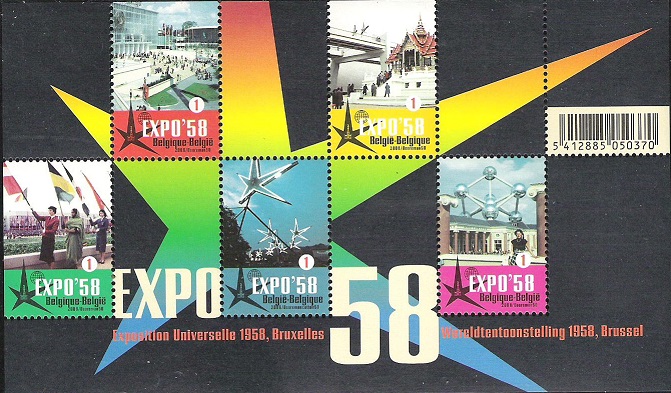
In the second session, Richard Jenkins showed a dozen sheets from German Stamp Exhibitions between 1925 and 1999, including cards and covers.
Alan Kane then related the story of the replica Irish Village, Ballymaclinton, at the 1908 Franco-British Exhibition. 80 different cards were produced and there were 6 million visitors. The village proved so popular that it reappeared at the 1909 Imperial International Exhibition, the 1910 Japan-British Exhibition and the 1911 Coronation Exhibition. Alan followed this with a selection of slogan cancels from Northern Ireland for events such as Stampex Ulster 1979 and the British Association for the Advancement of Science in 1952. He also showed commemorative covers from a range of festivals and exhibitions that took place in the late 1960s, including the Omagh Festival, Coleraine Religious Festival, the Craigavad Church Flower Festival and the Londonderry Ideal Home Show. He ended with items from the 1970 Ulster Show including the showground postmark and souvenir labels.

As Deputy Chairman, Mark Bailey thanked Richard and Alan for bringing along material, and the members expressed their appreciation for the evening's entertaining displays.
12th August 2014 - The Number 2
This meeting was given over to our members providing displays on the subject of the number 2, and eight members contributed displays. As is usual with a members' evening, some stretched the concept of the number 2 to provide material, and encompassed "Second" and "Double" as well as "2".
|
Patrick Reid: Underpaid Australian Airmails, all going through New South Wales, including some very scarce tax marks. The deficiency was doubled.
|
Alan Kane: Northern Ireland Second Class mail, and Instructional Markings that included the number 2, including Postage Due, Late Fee, etc.
|
|
Derek Steele: 2d charge marks, a Canada 2c envelope from Newfoundland, a Newfoundland imperforate pair, and a range of shades of a Newfoundland 2c stamp.
|
Michael Curling: Covers with either a 2d rate or 2d stamps used in multiples, also doubling of deficiency for Postage Due and a 2d Duty Stamp on a receipt.
|
|
Trevor Cornford: 1945 V-mail with a 2 in the date, postal or fiscal use of stamps with 2 in the value, and finally a letter posted in February (the second month of the year) requesting the supply of 2 razors.
|
Eric Holmes: A range of Gibraltar Registration Envelopes. The 2d Registration Fee was introduced on 2nd November 1902. Other Registration Envelopes showed either 2 in the date or had 2d stamps added.
|
|
Alwyn Lowe: Began with a display entitled "Once upon a time 2d would have bought one of these", including 2d stamps and other stamps with 2 in the value, cylinder blocks numbered 2 and 2A, and a duet and a pas de deux on stamps. He concluded with stamps showing two heads, biplanes, twin-engined aircraft, and two-wheeled vehicles.
|
|
Reg Browning: A box decorated with stamps that were being used for a second time. |
Brian Pugsley thanked all who had contributed to a varied and interesting evening.
22nd July 2014 - Annual General Meeting
At the Annual General Meeting, the Society's officers presented their annual reports. This was followed by the election of the Officers and Committee for the 2014-2015 period, with all the existing Committee members and Officers being re-elected to serve for another year. Types of membership and membership subscription rates were discussed at some length, and proposals voted upon. The result is that the adult membership subscription is being increased to £11 with a £1 discount for payment by 30th September, and a new type of reduced membership subscription (initially set at £5) is being introduced expressly for people who are not local to Wokingham, and hence do not attend meetings, but wish to sell philatelic material through the circulating exchange packets.
The late Eric Harris, a long time member of the Society, and his wife Joyce have worked tirelessly to raise funds for the Berkshire County Blind Society and the Oxfordshire Association for the Blind, by sorting and selling stamps donated to raise money for the two charities. As a mark of respect for Eric, who was a very kind and thoughtful man, following the Annual General Meeting, the Society held a special raffle, with 47 prizes donated by the members. The money raised from the sale of the raffle tickets will be passed to Joyce Harris for her to donate to the charities.
8th July 2014 - The Faroe Islands - Brian Hague
Brian Hague is the Honorary Secretary of the Scandinavia Philatelic Society and a member of the Faroe Islands Study Circle. With Geoffrey Noer and Preben Jensen, in 2010 Brian co-authored the 21st edition of the catalogue GF10, Faroe Islands Stamps & Postal History published by DAKA, Philtrade Denmark A/S of Copenhagen. In addition he has written numerous articles that have been published in the Journal of the Faroe Islands Study Circle.
We were very glad to welcome Brian who showed us material from the Faroe Islands. He explained that the population is about 50,000 of whom some 8,000 are registered footballers! The Faroe Islands are a group of 18 small islands clustered together in the North Atlantic, one of which has a population of just two people, and they are closer to Shetland than they are to Iceland.
Brian showed definitives with aerial views of a number of the islands. The islands were settled by the Vikings and they are part of the Kingdom of Denmark. They have had their own stamps only since 1975, when a series of 14 definitive values were issued.
Looking at when Danish stamps were used in the Faroe Islands, with effect from 1st January 1919, the rate increased from 5 øre to 7 øre for letters weighing less than 20 grams. The new 7 øre adhesives did not reach the islands in time, so the Danish Post Office authorized Andreus Ejnar Emil Godskesen Andersen of Thorshavn to diagonally bisect 4 øre stamps because there were no 2 øre stamps available. The period of usage was only for 28 days - from 3rd January to 31st January, although the majority were used before 13th January. The quantity of basic stamps available is believed to have been 8 sheets of 100 stamps that would have produced 1600 bisected stamps. When these ran out stamps cut from 4 øre Newspaper Wrappers were bisected. Finally 5 øre stamps were overprinted 2 øre by hand, until the 7 øre and 2 øre stamps arrived at the start of February 1919. The next time that the mainland rate rose, the old rate remained valid in the islands for a time. Examples of all these were shown, and Brian also displayed provisionals from World War 2, made by overprinting Danish stamps.

The next section was of 100 stamps engraved by Czesław Słania. This was an impressive assembly of material including design artwork.

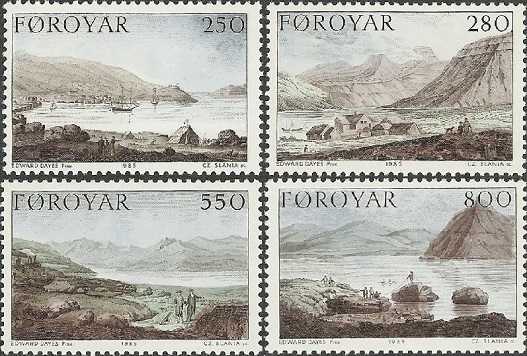


In 1979, Czesław Słania created a masterful stamp depicting the Faroese Ram. The artistic detail of the stoic looking sheep is quite mesmerizing with its rich detail and the engraver's brilliant use of shading. The ram does not look flat in appearance, but appears three dimensional. Brian noted that in particular, the left corkscrew-shaped horn appears to lift off the stamp. By using and excluding the use of engraved lines, the engraver created dark and light areas.

Another new issue in 1979 commemorated the 60th Anniversary of the first Provisionals. Next we saw a selection of modern issues, which included portraits of prominent Faroese authors and poets.

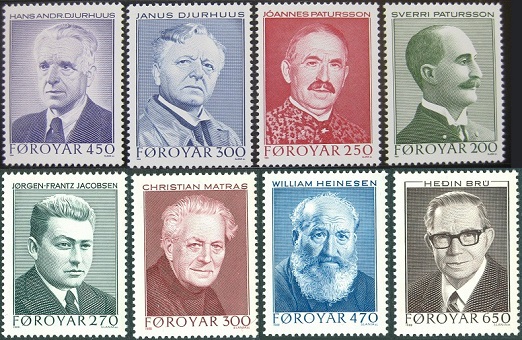
We saw the 1980 Flora issue, designed by Czesław Słania but not engraved by him, some maxi cards of Exhibitions, and an issue for the 50th Anniversary of British Occupation (during World War 2).

These were followed by stamps showing mailboats (Brian noted that each island has a duty to provide a crew to take mail to the next island). In 2001 the 25th Anniversary of the Post Office was celebrated. Brian displayed a further selection of maxi cards, the 2013 joint issue with Greenland showing the Faroese shore station in Greenland, and a picture of a machine for automated Parcel Delivery. Finally in this section, Brian gave us a brief introduction to the Faroes' Postal History, as preparation for the second part of the evening's display.
The second part focussed on Postal History, concentrating on the World War 2 period when the islands were occupied by British forces. Denmark tried to stay neutral, but communication with the islands was difficult with a war going on around them. A boat was sent from Denmark in April 1940, but recalled as the Germans invaded the country. After the invasion, censorship was introduced, and Brian showed a 1940 cover opened, not returned and redelivered in 1941.
A small British garrison occupied the Faroes in 1940 and these were replaced in 1941 by the Lovat Scouts (TA) who got on very well with the Faroese. They had been trained in Jasper, Canada for Alpine duties but on leaving the islands were moved to Nairn to guard Balmoral and were replaced in the islands by the South Staffordshire Regiment. A regiment of Pioneers constructed a landing field for aircraft at Sorvaag. When the war was ended, this was turned over to the Faroese Government and was used as a commercial airport. In 1946 Faroe Airlines made the first attempt to establish a regularly scheduled air service using Douglas DC3 Dakotas. The first flight of Faroe Airlines took place on 10th July 1946 (Copenhagen - Prestwick - Vagar) with the return flight occurring on 12th-13th July. The air service was discontinued on 25th September 1946. A few Norwegian Navy vessels worked out of the islands, and many Norwegians from their Merchant Marine volunteered for the Royal Navy. Thus, British Forces were stationed in the Faroes from April 1940 until the late Summer of 1945. Field Post Office (FPO) 219 was used in the Faroes from August 1940 until September 1943, and FPO 611 was established on 4th June 1942 and continued to operate until March 1944.
Material shown included FPO cancels, examples of postal forms, cinderellas from the Danish Fascist Party, and mail via Lisbon to Germany (using businessmen Johan and Viggo Beckmann, Rua Dos Fanqueiros 83-85, PO Box 164 in Lisbon; Viggo Beckmann functioned as an intermediary to Thomas Cook & Sons Ltd. PO Box 506, Lisbon). When there were stamp shortages, a 'value paid' marker was used. NVI stamps were also used, and a Neopost machine ws imported from the UK. A novel incentive to pay tax was a tax form which, when receipted, allowed the holder to buy alcoholic drinks.
Civilian mail was censored on Vagar, the island where the airfield was located. The airfield saw little use until the 1960s. From 1983 onwards, the main postal delivery for the islands has been made by helicopter. The final section covered the Greenland shore station at Faeringhavn. Brian showed us parcel cards and other ephemera related to the postal service.

Brian Pugsley thanked Brian Hague for his clear and amusing explanation of a subject unfamiliar to most, illustrated with a splendid range of material, before making the usual presentation.
24th June 2014 - The Motorcycle - John Hayward
John Hayward, who until recently was the President of the British Thematic Association, has been collecting on the theme of "The Motorcycle" since 1979. The first part of his display was a relatively informal assembly of material that illustrated the wide range of items that can be collected around a particular theme, and how a degree of lateral thinking can enhance the diversity of items.
John opened with Egypt Express Delivery stamps from 1926, including some of the notorious misperforated stamps produced by Royal Directive. The need for a sharp eye was shown with the 1994 GB Age of Steam issue, where there is a motorcycle and sidecar under the bridge on the 41p value - more easily seen on a PHQ card. A novel variety was Spanish stamps featuring a motorcycle from an ATM machine, where John discovered, after research, that the paper had become discoloured because of the build up of heat in the machines that were located in sunny places.
|

|
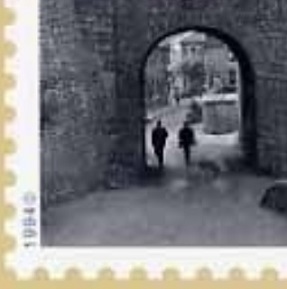
|
Some countries produce First Day of Issue documents in addition to covers, and we were shown examples from France on vellum and Austria on (cheaper) paper. Strike post and local issues, especially on cover, are a good addition to a thematic collection, as are Christmas Seals, of which we saw examples from USA and Denmark.
|
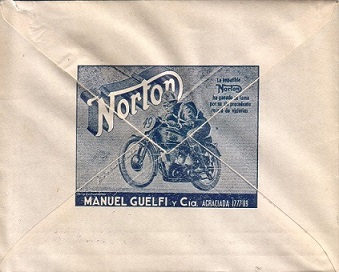
|

|
A number of postal administrations have introduced personalised stamps and John showed us his own featuring a photograph of himself with his own motorcycle in Cheddar Gorge. Post Offices have publicity leaflets and posters for specific issues, and these can often be obtained once they have been removed from display. Any collection is enhanced by Proofs and Essays, and relevant Perfins can be added too.
As a diversion, John showed a spoof of the Sudan General Gordon issue, with the camel replaced by various other means of transport, including a motorcycle (and a rhinoceros!).
Suitable cancels are relevant and we saw examples from Germany and Czechoslovakia and one from a mobile box at a motorcycle meeting at Silverstone. Meter marks too fall into this category, as do relevant cachets.
|

|
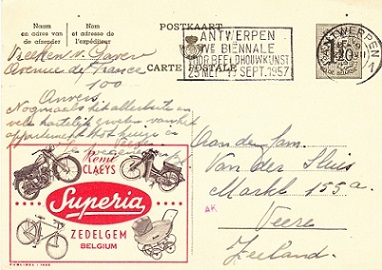
|
As an example of lateral thinking John displayed a (stamped) invitation to the cremation of a dead Speedway rider.
Postal stationery and Advertising envelopes can also be used and we saw material from Portugal, Russia, Romania and China, where the postal stationery includes a National Lottery ticket.

Other suitable material includes Telegrams, and we were shown a Belgian Congo request for motorcycle engineers, as well as Greetings Cards, PTPO advertising envelopes and Post Office Advertisements. The first half of John's display finished with an 1892 US cover advertising the Daimler motorcycle engine and a Tuf Postal box showing a Datapost motorcycle.
The second part was more formal and consisted mostly of sheets from John's International Gold Medal eight-frame display "The Iron Steed". This followed the strict rules for Thematic entries imposed by the FIP. The whole exhibit was on double-sized sheets, which allow more flexibility in displaying material and make it easier to accommodate larger items. The introductory plan outlined the development of the motorcycle over 130 years. The sections shown were Commercial, Post Office, Police and Military. Lack of space meant that the sections relating to Sport and Road Safety were omitted.
The exhibit opened with an 1897 cover for the New Beeston Motorcycle Company. There were many philatelic varieties: flaws, perforations etc. Interesting items included an NSU envelope interior and the 1920s Post Office in the DKW Factory. We were told the story of John's attempts to get a Kawasaki cancel, and saw what he eventually got - a Japanese notice of Failure to Deliver a Signed For Letter - with a Kawasaki cancel.
A UK Telegram featured the BSA Bantam. and a miscut booklet - bought at the Camberley Post Office as a normal one - made a good story.
St Helena has a local delivery service by scooter. We were shown a rare commercial cover - few make it off the island.
Express services were represented by examples of Berlin Postschnelldienst and China Express Post (featuring a Harley-Davidson). These were complemented by covers sent using the Royal Signals' Despatch Rider Letter Service.
|

|

|
The final section showed material relating to relevant clubs and associations. John remarked that it is important to know the acronyms; for instance, the German NSKK was the Nationalsozialistisches Kraftfahrkorps, the National Socialist Motor Corps.
Mark Bailey thanked John for giving us a comprehensive coverage of the subject and a wonderful exposition of how to put together a Thematic Exhibit.
10th June 2014 - Club Competition & Open Competition
For the Society's Annual Competition evening, entries were received for four classes, but only one class had more than a single entry. The results were as follows:
THE WDPS ADVANCED TROPHY
The Advanced Class had four entries, all considered by the judges to be of a high standard.
Winner Patrick Reid - The CTMS/T Tax Marks of Tasmania
2nd place Trevor Cornford - Sir Ernest Shackleton's First Antarctic Voyage
3rd place Eric Holmes - Spanish Stamps used on GB Mail 1810-1816
4th place Derek Steele - Pioneer Newfoundland Airmails
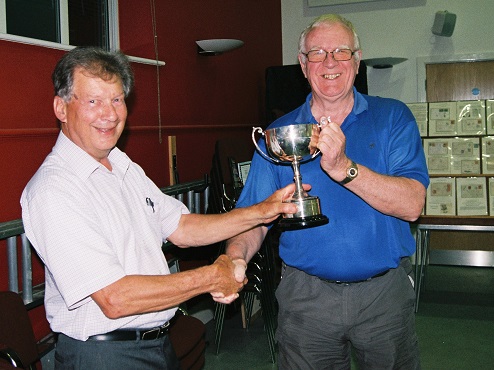
Tony Stanford presenting Patrick Reid with the WDPS Advanced Trophy.
(photograph by Anthony Simmonds)
THE WDPS THEMATIC TROPHY
Awarded to Alan Kane - Police Official Transport

Tony Stanford presenting Alan Kane with the WDPS Thematic Trophy.
(photograph by Anthony Simmonds)
THE PETER GRAHAM CUP FOR POSTAL HISTORY
Awarded to Derek Steele - Scottish Additional ½d Wheel Tax Marks Applied in London 1813-1839
This showed a good variety of the handstamps applied.
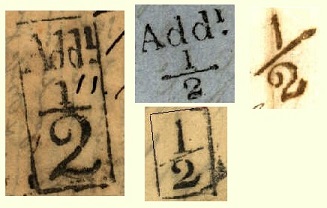
Tony Stanford and Anthony Simmonds from Maidenhead were the judges, and they provided constructive comments on all the entries. Chairman Brian Pugsley thanked them for their hard work and the positive nature of their comments.

Tony Stanford commenting on the competition entries.
(photograph by Anthony Simmonds)
There was a single entry in the Open Competition. This was an exhibit by Eric Holmes on the subject of the Ionian Islands postage stamps issued in 1859. This was a nice assembly of material from a difficult area.

7th June 2014 - Thames Valley & District Philatelic Federation Meeting
A total of 34 people gathered at CABI near Wallingford, Oxfordshire for the annual Thames Valley meeting, organised by Patrick Reid and Dane Garrod. This meeting was held in conjunction with the Royal Philatelic Society London. The attendees were welcomed by Christine A. Earle on behalf of the President of the Royal Philatelic Society London, Chris King, and by the Thames Valley & District Philatelic Federation's President, Tony Stanford.
The keynote display was by Richard Stock on "Sudan - The Camel Postman Issues 1897-1991". Richard and his wife Jenny had travelled to Wallingford from Cheshire, and Richard's interesting talk regarding the stamps designed by W.E. Stanton inspired by a camel carrying rolls of carpet and also mailbags was enjoyed by a very appreciate group of philatelists. Sudan is the second most densely camel-populated country in the world after Somalia, and the display included numerous essays, proofs, colour trials, working die proofs, stamps, errors and varieties of overprints and the various SG (Sudan Government) perfins, as well as booklet stamps and examples of usage.
After Robert Galland gave the vote of thanks and people had viewed Richard's display, there was a short series of displays by attendees, before a break for a group photograph and lunch.
During the afternoon there were further displays of one or two frames of material. The subjects displayed were as follows:
Alan Cowie Japan - Pacific Cruise Souvenir Covers 1939-41
Gerald Marriner Belgian Congo - World War II
David Tett Mail of POWs in Taiwan, Korea and Manchuria
Mike Payne The Spitfire Story
Malcolm Gascoyne London Coffee Houses
Tony Stanford GB Admiralty Officials
Maurice Taylor Fiscal stamps on 18th & 19th century Bills of Lading to/from Madeira
Stephen Marks The first definitive issue of Albania 1913
Wendy Buckle Latvia 1919-1921
Eric Holmes Ionian Islands - GB Period, and Madeira Revenues
Mark Bailey British Tea Dividend Stamps
Anne Stammers Rocks to Riches: Silver
Malcolm Ray-Smith Tudor Letters
Derek Steele Scottish ½d Wheel Tax Marks applied in London
Ian King Argentina - Wine & Food
Simon Richards Mauritius
Tony Simmonds Nigeria - 1961 Definitive Issues
Sue Hopson Seychelles - World War II Civil Censorship
Trevor Cornford Shackleton - A Story of Endurance

The attendees at the meeting at CABI (photograph by Dane Garrod)
Dane Garrod thanked all who had attended and brought such a wide variety of material. He reiterated thanks to the keynote speaker, and encouraged all who had attended to come again next year.
Complimentary remarks were made about how enjoyable the day had been and the meeting closed around 4.15 p.m.
13th May 2014 - Invited Members' Displays - Peter Alford and Alan Kane
Peter Alford began the evening's displays, and the first part covered the issues of Lundy from 1929 to 2008. He noted that during hard times, simply printed 'bus tickets' were used to pay the postage to the mainland. There was a range of Airmail stamps, including proofs and the stamps in issued colours, as well as some overprints and (blatant) forgeries. The Airmail service was interrupted by a crash in 1940, and Peter explained that there have been two further crashes since. He then displayed a range of the 'Appeal' stamps used to raise funds in an attempt to buy the island, and finally a range of covers, noting that both GB and Lundy stamps were required.
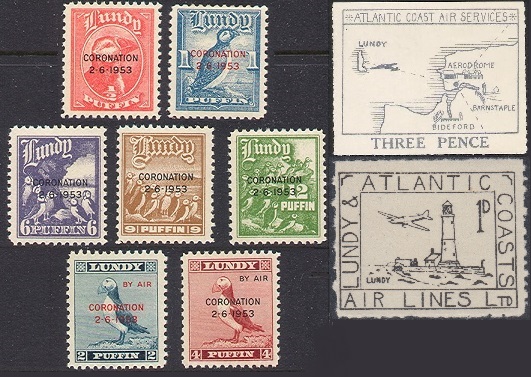
The second part of Peter's display consisted of a colourful selection of stamps licensed for International use on postcards only. They are produced by Universal Mail United Kingdom Ltd. and are on sale at a number of tourist attractions. They depict a wide range of such attractions in full colour, including Stonehenge, the Giant's Causeway and the Tower of London. A strip of five produced for the 2010 Festival of Stamps included the front of 41 Devonshire Place, London, the home of The Royal Philatelic Society London.

Peter's final section comprised a wide range of Post & Go stamps, all with receipts. Some were in sheets, and stamps for extra services, such as Special Delivery, were also included. This led to a brief discussion on which of these are available from the Philatelic Bureau.

After the refreshment break, Alan Kane showed military mail, mostly related to Northern Ireland. He began with a display of cards relating to Regiments and their name history over time. Most of the units featured have now disappeared, and Alan explained that the Irish Guards regiment was formed in April 1900 by order of Queen Victoria to commemorate the Irishmen who fought for the British Empire in the Second Boer War.
Alan showed a range of Postal History including an 1831 cover to Dublin, letters relating to the Royal Inniskilling Fusiliers and registered covers from the training camp at the Abercorn Barracks in Ballykinler.
During World War II, most US troops came for training in Northern Ireland and Alan displayed a range of APO cancels, followed by V-Mail (short for Victory Mail, similar to Airgraphs) and then a selection of censored mail - some censored in Liverpool, and some by the RAF.

Alan noted that Long Kesh prison was guarded by the military, although there were Prison Officers within. During the 'Troubles' there was an FPO canceller for each town of any size, and he showed us a range of these. Next came some 'Blueys' (Aerogrammes) with usage through Aldergrove and a number of local cancels. Alan completed his display with some philatelic covers from Ballykelly.
Mark Bailey, standing in for Brian Pugsley, thanked both Peter and Alan and remarked that this was yet further evidence of the wide diversity of collecting interests within the Society.
22nd April 2014 - Malayan Miscellany - Peter Cockburn FRPSL
The members were entertained by Peter Cockburn with an excellent 'Malayan Miscellany'.
To ensure that we knew where he was talking about, Peter introduced his display with a 1683 map of Malaya by French cartographer and engineer Alain Manesson Mallet (1630-1706). It was surprisingly accurate given the state of technology at that time.
|
Peter was first attracted to Malaya as a collecting area when he purchased some Federated Malay States stamps featuring the 'Tiger' design. This design was used for both Postage and Revenue stamps and he showed larger format Judicial stamps. Next came the stamps featuring the 'Elephants' design from many states in Malaya. These were followed by Revenue stamps of triple-stamp size including those for Marine Policy, Foreign Bill, Judicial and Revenue, and the smaller versions that were introduced to combat fraud committed by overlapping of previously used stamps.
|

|

Peter then showed a range of perfins and their predecessors (signatures, cancels and chops) introduced to combat theft and fraud and some early meter marks from the 1920s. The next frame concentrated on collection of revenue from 1819 onwards. There were Impressed Duty Stamps, overprinted Indian Stamps, a Japanese Occupation stamp and revenues from the reigns of Kings Edward VII, George V, George VI and Queen Elizabeth II, all on documents. Although the Stanley Gibbons' catalogue lists these stamps as postage stamps, they are actually revenues, and the highest value seen postally used is $100. They were inscribed 'Postage & Revenue' to save money. However, the Federated Malay States had a separate series of Revenue stamps. Usage was also shown of a Thai revenue stamp used in Kedah, when the Japanese gave the state to Thailand in 1942. The final frame of the first half showed Postal Stationery cards from North Borneo, including a proof with the imprint of Blades, East & Blades (printers).
For those who were disappointed at the dearth of postage stamps in the first half, the second half included postage stamps. The first frame was a correspondence with Postal History interest comprising letters from various young men to a Miss Lucy Goh who lived in Penang. One of the men had been guarding the Lancashire Regiment that had mutinied in 1946.
|

|
The second frame showed North Borneo War Tax stamps and included a very scarce local cover and a cover that went on the California Clipper Air Mail service.
|

|
The third frame showed a selection of BMA Malaya material. Although issued in 1945, planning for the issue had begun in 1943. There were 4 sheets of the 1c value, all superficially the same, but actually all different, having been overprinted in Kuala Lumpur, London, Melbourne, and London on a new printing. The frame included proof strikes of the overprint and a range of Specimens, including missing Specimen (in a triplet) on the $5.
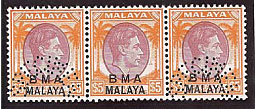
Frame four showed Postal Stationery, with a range of postcards, including old ones cancelled and re-used with new stamps affixed and a selection of Registered Envelopes. Frame five showed modern material from the Sabah Agricultural Series issued in October 1986, with perforation and watermark varieties and use of marginal code numbers to denote the date. The final frame returned to Revenues, with items from the De La Rue Archives, items with mixed recess and lithographic printing, further printings from Harrisons and finally some local printings.
8th April 2014 - The Items Speak For Themselves
This meeting had a quiet twist, as those presenting material gave a "Silent Display". The following members displayed material without any spoken word of explanation:
|
Eric Holmes: Part of the 1977 Silver Jubilee British Commonwealth Omnibus issue. |
Chris Rayner: "Mum's the Word!" - a selection of Queen Mother stamps. |
|
Dennis Proctor: German material from the Third Reich, Federal Republic and the DDR. |
Tom Cope: A large selection of aircraft on stamps, especially Concorde. |
|
Brian Pugsley: Mauritius King George VI stamps with a selection of varieties.
Marianne Murray: The Great Britain issue for King George V's Silver Jubilee in 1935. |
Mark Bailey: A collage of yellow-coloured stamps spelling out YELLOW, sheetlets depicting bugs, beetles, birds and butterflies, and Malta's early stamps.
Derek Steele: The Scottish ½d Wheel Tax. |
|
Trevor Cornford: Explorers from Cook to Nordenskjold. |
David Gerken: Bridges and related items. |
|
Peter Alford: Lighthouses on cigarette cards. |
Patrick Reid: The CTMS/T Tax Marks of Tasmania. |
|

|
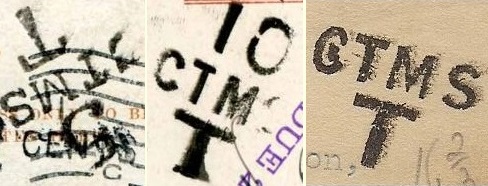
|
The format was considered a success and may well feature in a future programme.
25th March 2014 - Postcard & Cinderella Competition
This year there was just 1 entry in the cinderellas competition. However, there were 7 entries in the postcards
competition, and these were judged by the members. The results are as follows:
CINDERELLA CLASS
1st Mark Bailey - European Tea Publicity Labels
POSTCARD CLASS
1st Mark Bailey - Postcards for George Payne's Government Tea
There was a tie for second place:
Equal 2nd Trevor Cornford - British National Antarctic Expedition 1901-1904
Equal 2nd Julian Burgess - Bognor, Richard Sharpe, House of Stamps
Mark's exhibit included an attractive composite set of six postcards advertising Superb G.P. Government Tea that featured scenes from the life of King Edward VII and formed an image of the King's head.

|
Julian's exhibit featured an unusual story. The Rising Sun public house, Chichester Road, North Bersted, Bognor Regis, became famous for its rooms decorated with postage stamps. The decoration using stamps was begun in Queen Victoria's Diamond Jubilee year, 1897, when landlord Richard Sharpe accepted a wager to decorate one room entirely with stamps from his collection. The room became known as the Jubilee Stamp Room. Over the following years, stamps were added to other rooms and the building became known as the Stamp House.
|

|
|
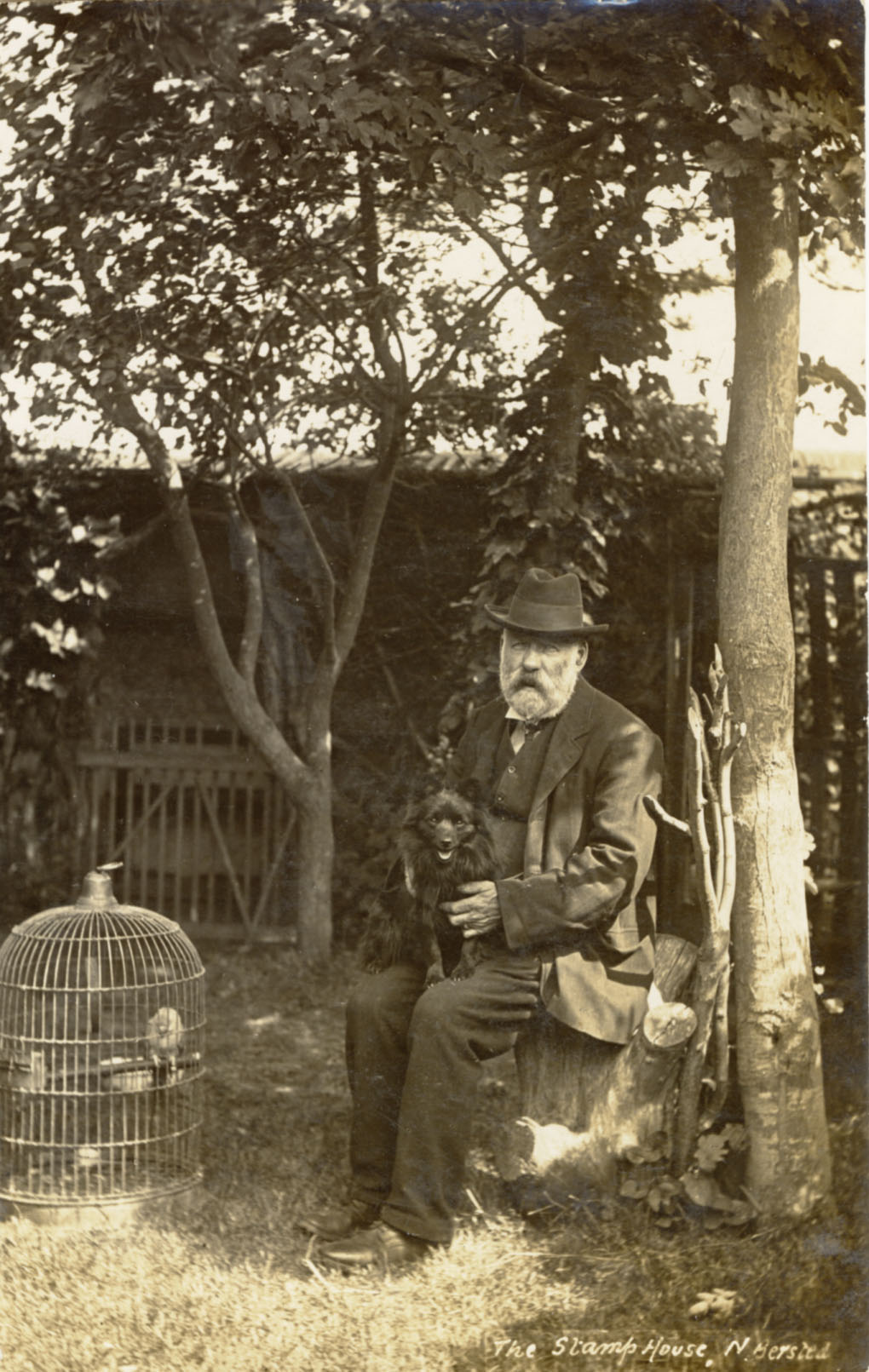
|
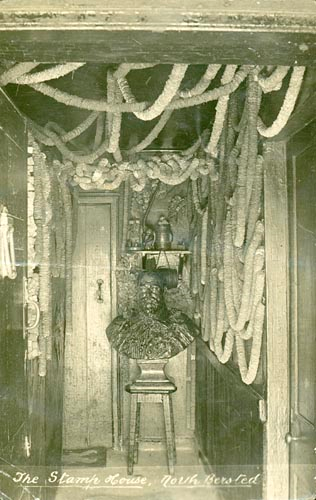
|
After the competition, there was time for members' displays. Patrick Reid showed an interesting collection of privately produced Letter Cards from Tasmania and some long folded panoramic postcards. Trevor Cornford displayed a selection of postcards of the Victoria Falls.
11th March 2014 - Winter Sports, Franz Joseph and Jubilee Cards - Geoff Richardson
We welcomed Geoff Richardson, Chairman of the Austrian Philatelic Society, who had brought along a fine range of Austrian material, relating in the first part of the evening to Franz Joseph I (1830-1916), Emperor of Austria and King of Hungary, and concentrating on Winter Games in the second part.
|
Geoff specialises in postmarks of the Franz Joseph era, and he began with a selection of these on items of postal history, followed by a good range of the correspondence cards issued to celebrate Franz Joseph's 60th Crown Jubilee on 2nd December 1908.
|
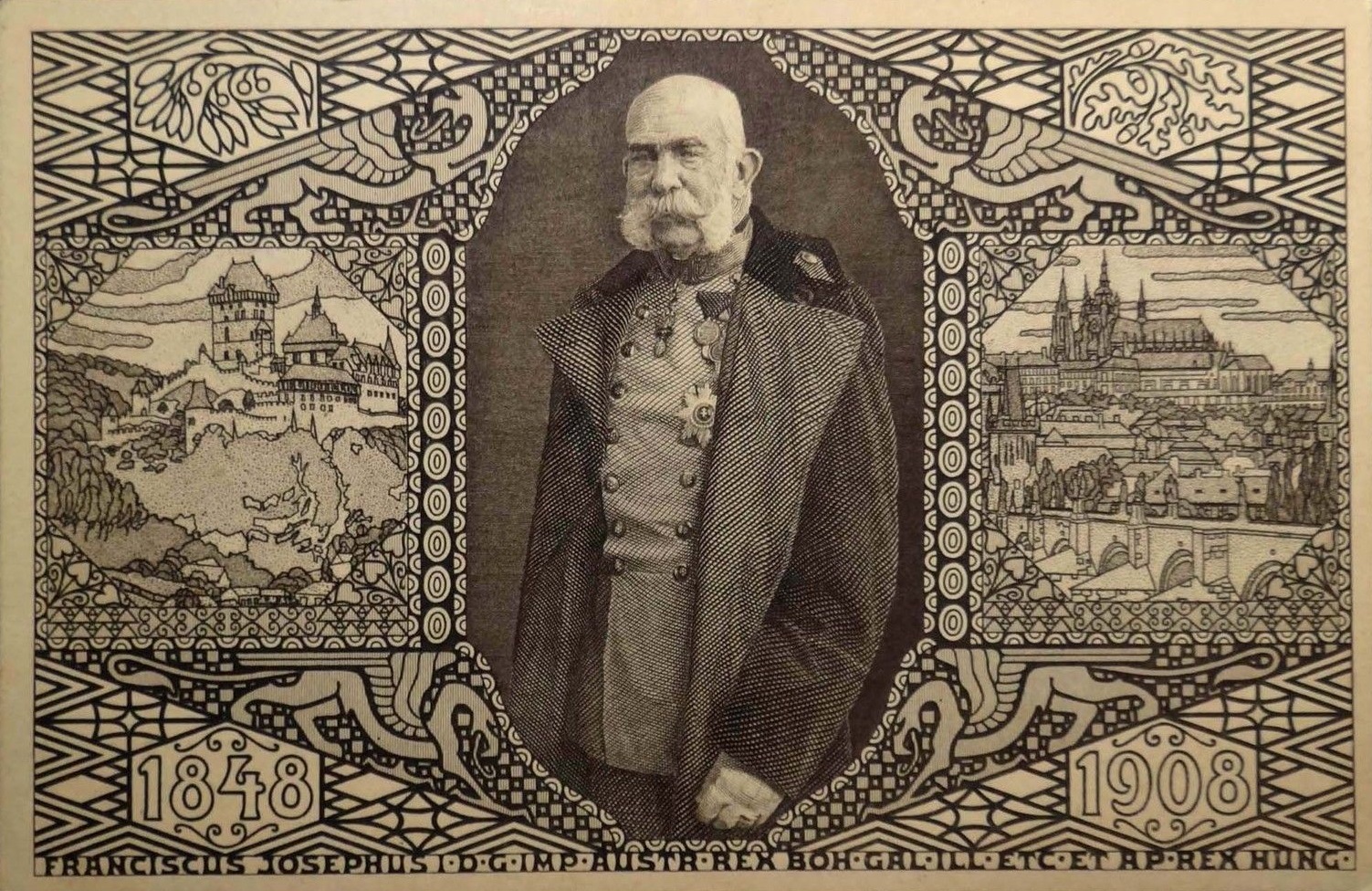
|
|
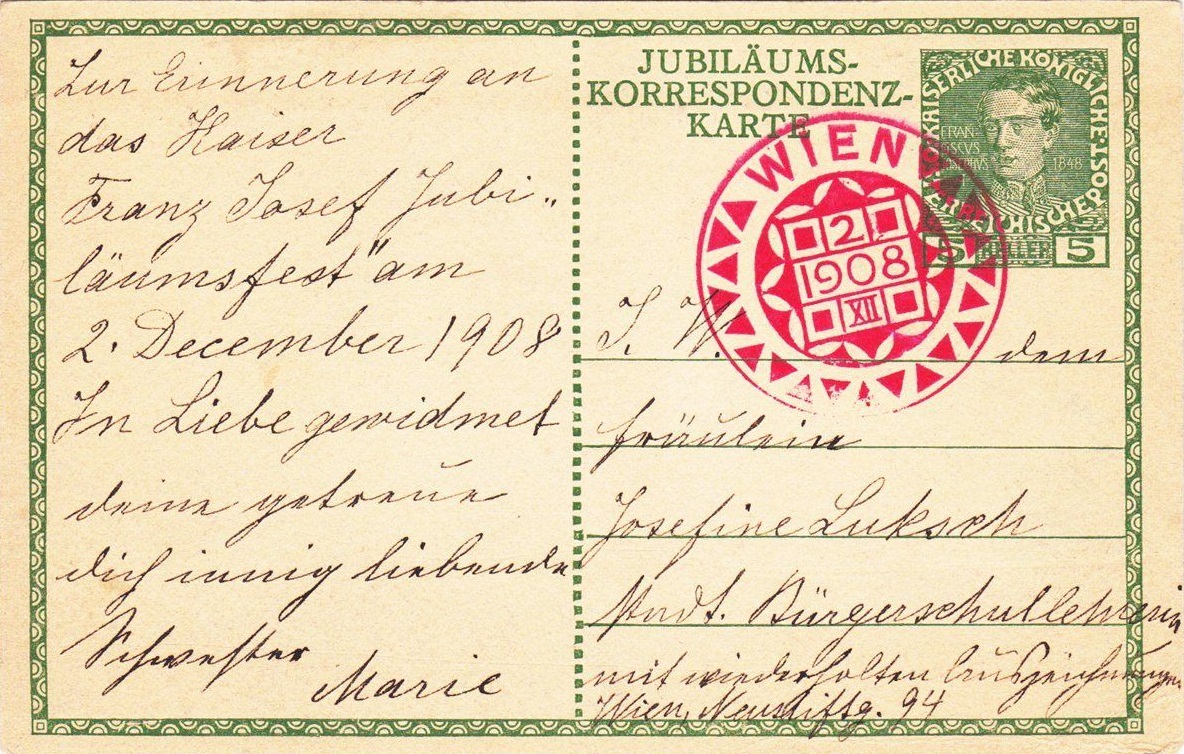
|
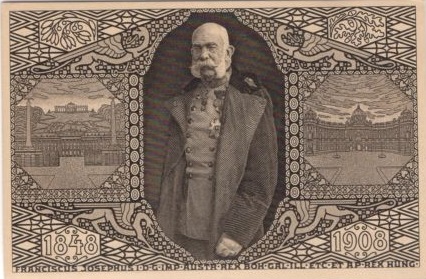
|
In January 1869, Dr. Emmanual Hermann of Vienna, a professor of economics, revived the idea of producing printed postcards that had first been suggested by Dr. Heinrich von Stephen in 1865, at the Austro-German Postal Conference held in Karlsruhe, Germany
and on 1st October 1869, the Austrian Post Office issued the world's first official postcard. This proved to be a great, popular success and around 2¼ million postcards were sold in the first 3 months. Geoff's display included a specialist study of the 1869 postcard, including examples of scarce plates.
|

|
Returning to Franz Joseph, Geoff showed a collection of stamps depicting the Emperor; apparently there are 42 different perforations available.
To close the first part of the display, we were shown stamps and some sheets from the 60th Anniversary issue, and stamps issued to mark the Emperor's 80th Birthday.
|
The second part of the display concentrated on Winter Sports. A remarkable item was a registered cover on a Winter Games ticket, posted underpaid and taxed! We saw a study of varieties on the 1964 Innsbruck Winter Olympics set and a range of covers with these stamps. A similar selection for the 1976 Winter Olympics was also shown. A range of Airmails showing or related to Winter Games followed, and the evening was completed with a selection of Balloon Posts, mostly related to the 1964 and 1976 Winter Olympics, but also covering other Winter Games events.
Chairman Brian Pugsley gave the vote of thanks, in particular complimenting Geoff on the quality of his write-up.
25th February 2014 - The Colour Green
Members enjoyed the following material displayed on the theme of the colour green:
|
Michael Curling - A £1 postal order from the Orange Free State to Cape Town with 3 Cape of Good Hope 1d stamps on the back for the 3d fee, a 1936 cover from GB to India with a 9d green stamp, Antigua ½d stamps on covers to Berkshire, green stamps from Tibet, a green cover from Reading via Wokingham to London, a Russian passport stamp, and KGV local postal history. |
David Gerken - Bridges on mainly green stamps, including covers for the 1968 Menai Bridge and Ironbridge, a 1912 green stationery card with the LZ11 Viktoria Louise, a cover flown to Cardiff and then carried by zeppelin to Brazil, 1933 Great Western Railway Air Mail stamps, QV lilacs and greens, and cub jamboree stamps from Austria and Canada in the 1950s. |
|
Reg Browning - Blocks of 4 Trinidad and Tobago green stamps overprinted for OFFICIAL use, in different text styles. |
Chris Wootton - A selection of green stamps from recent acquisitions including a number of different shades of green from various countries. |
|
Roger Sammons - A selection of stamps from Greenland.
Dennis Proctor - Souvenir sheet marking the 15th Anniversary of the formation of the German Democratic Republic. |
Trevor Cornford - stamps with some green in the design, including Belgian revenues on documents, Rhodesian stamps and postal history, plus a postcard showing the verdant green surroundings of the Victoria Falls, a Southern Rhodesian QSL card and a green customs label. |

|
|
|
Derek Steele - Green Newfoundland peculiarities, including the green 3d triangular stamp (1857), 1c green examples with printing errors, John Cabot's ship stamp, the 1880 series with green colour variations, and green stamps printed with fugitive inks looking washed out. |
Alwyn Lowe - a complete sheet of the ½d green 1940 Stamp Centenary overprinted for use in the Morocco Agencies, green stamps from the Commonwealth and Costa Rica, and stamps, postal stationery and postcards from Sweden. |
|
Eric Holmes - GB KE7 and KGV mint green stamps in dark and light shades (including blue green, yellow green, apple green, etc.) and Gibraltar ½d and 1s stamps including olive green and yellow green shades. |
Ivan Dickason - Mint blocks of green stamps from Antigua, GB, Bermuda, Cyprus, Gibraltar, Northern Rhodesia, St. Kitts, Turks & Caicos, South Africa and the British Virgin Islands. |
|
Alan Kane - Northern Ireland-related stamps with green on them including the £1 Carrickfergus Castle stamps, Northern Ireland regionals and the 2008 Glorious Northern Ireland smiler sheet. |
Mark Bailey - Green stamps from around the world, plus a postcard franked with a green German stamp, cancelled by a slogan postmark advertising International Green Week in Berlin. |
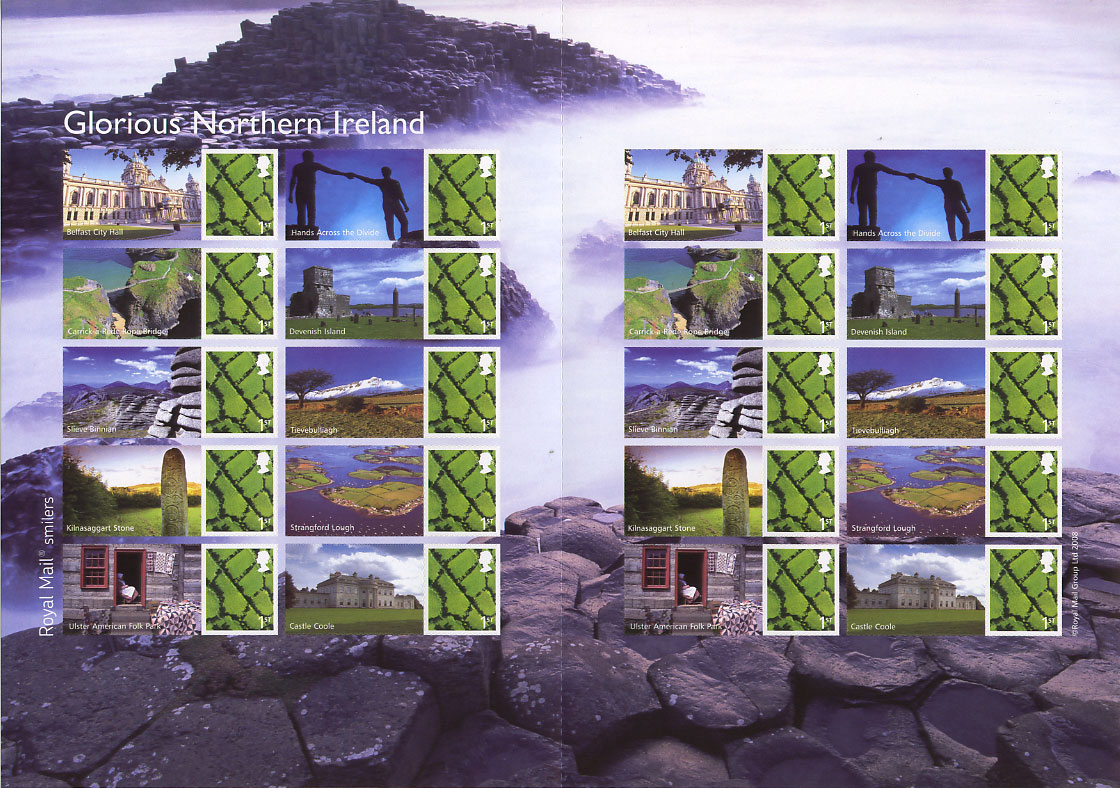
Brian Pugsley thanked everyone for displaying such diverse material.
11th February 2014 - Quiz Night
Ray Hook presented his usual mind-stretching quiz for the entertainment of 3 competing teams. At the half-way point, the teams were tied with 25 points each, but in the end, prizes were won by the members of the team led by Alwyn. A good evening's entertainment was enjoyed by all.
28th January 2014 - Material obtained in 2013
Michael Curling began the displays with an eclectic mix of material including a South African Mineral Licence, 1850s sheet music for the Postman's Polka, a bundle of New South Wales cheques from New Zealand, an image of the Duke of Wellington, telephone-related covers and a postcard shaped like a telephone.
Reg Browning brought along items that he had bought at auction, comprising a selection of Commonwealth material. This included the British South Africa Company stamps to £2, QEII Cayman Islands to £1, higher value Bahamas keyplates, Gibraltar QEII and the Victoria Charity issue of 1897.
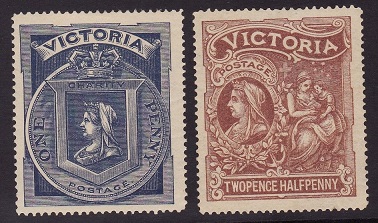
Trevor Cornford dedicated his display to Rodney Smith for the work he does serving us teas and coffees. He showed a set of Japanese cards about the tea ceremony, a Lipton postcard from Ceylon (Sri Lanka), a tea-related card featuring the CND, a postcard of Vesta Tilley, some 1930s cards from Russia that revealed an interesting itinerary for the writer, a 1790 disinfected Greek cover, a pullout card shaped like a camera from 1914 and finally a modern vandalised cover.
Derek Steele had a Mulready envelope and a 1941 Newfoundland cover featuring the 1940 5c Grenfell stamp, together with background material on Sir Wilfred Grenfell who was a medical missionary.
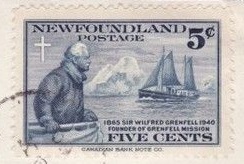
Eric Holmes displayed a Madeira revenues collection with joint issues for Madeira and the Azores including use on document and similar material for Madeira only. This was followed by a Bermuda ½d Queen Victoria Die Proof and overprints on Gibraltar. He followed with a Sperati forgery and varieties on Spanish overprints and Specimens. Next came postcards relating to battle honours, the Gibraltar 1956 Specimen overprints on a Parcel Post cancel, the scarce Civil Secretary arc cancel, six-packs of stationery with wrappers, GB used in Gibraltar, Falmouth Ship Letter cancels on material from various origins and finally a Returned Letter from Gibraltar with handstamp.
Mark Bailey showed a varied selection of 19th century Channel Islands mail covering the 1800s to 1890s. This included a letter home to Guernsey from a boarding school in Chesham, a Ship Letter from Bahia that was landed at Cowes before being delivered to Guernsey, an 1858 letter from Jersey to Philadelphia via Liverpool, a French stamp with a Jersey MB (Mobile Box) cancel, examples of the two types of Alderney 965 cancels, a ½d postcard used from Jersey, a postcard from British Guiana to the ex-soldier, stamp dealer and Consul for Colombia in Jersey George Patrick Campbell, a Guernsey to London insurance letter, correspondence to Germany, a rare Jersey 2d Tax Mark on a letter from France and an item sent from Alderney to Sweden.
After the refreshment break, Alan Kane displayed a lettersheet and postcard of Carrickfergus castle and a personalised stamp sheet.
Chris Wootton showed all 19 British First Day Covers for 2013 and one for 2014.
Patrick Reid brought along two complete sets of the 1898 Tasmania Illustrated Stamped Envelopes, both mint and used (only 315 sets were printed) and a small range of scarce Postage Due covers.
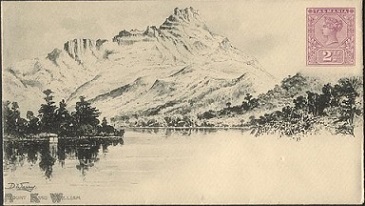
|
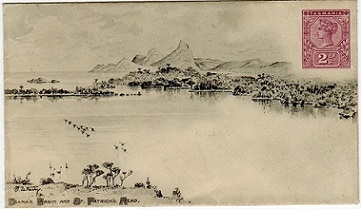
|
Alwyn Lowe showed 2012 issues from Monaco, Austria and Sweden, including many booklets.
In a reprise, Mark Bailey displayed cinderella material from Sutton & Co., Parcel Carriers, a cover from Berlin to Herm Island in the Channel Islands, missent to Herm, Landes in France and returned to sender, a selection of QV 1d surface printed fiscal material, including usage on some invoices relating to carriage repair and printing from Wokingham firms. This included the Inland Revenue 1d Dies 1, 3 and 4 on documents, Die 2 on a marriage certificate and finally postal usage on a cover to Hinckley, Leicestershire.
Chairman Brian Pugsley concluded the evening with blocks of King George VI material from Trinidad and Tobago, Jamaica, Hong Kong (including a flaw), Gambia and the Seychelles.
14th January 2014
Our Chairman Brian Pugsley opened his display by giving an introduction to his philatelic life. A friend inspired Brian to start his stamp collection, but he soon found that collecting everything was hard work. He was distracted by other things as a teenager, and then got married and did not return to the hobby
until his daughter joined the stamp club at her secondary school. After much thought he decided to collect British Empire King George V, and bought a collection of the 1935 Jubilee issue. Then he looked at the catalogue prices for King George V stamps, and changed to collecting Commonwealth King George VI.
Starting in 1993, he set himself the target of collecting all of the King George VI stamps in a mint condition. We saw some of the fruits of his labours, with his collections shown in alphabetical order from Aden to Bahamas completing the first part of the display. Brian does not collect watermark varieties, but he does collect shades and perforation varieties. Most of the stamps have the King's head on them. For ease of recognition, varieties were shown with enlarged images on the page.
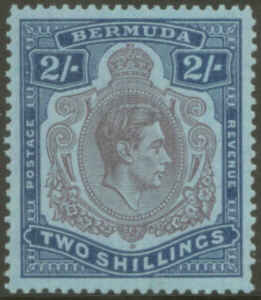
|
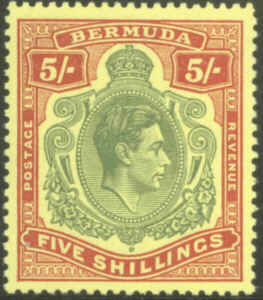
|
In the second part of the evening, Brian continued to relate his history. He joined the WDPS and the King George VI Collectors' Society to support his hobby. He described his delight at being the successful purchaser of a Grenada 2½d stamp at auction. The stamp content of the second part covered Barbados to British Honduras, with the usual selection of varieties. However, with particular reference to Bermuda, he emphasised that he does not collect varieties on large keyplates as they are too expensive. Notable in this part was a set of Bermuda essays, though sadly with no provenance.
|
|
Brian concluded by saying that in terms of being able to complete the display of the rest of the Commonwealth issues between 1936 and 1952, he hopes to continue throughout his chairmanship to reach the end!
|

|
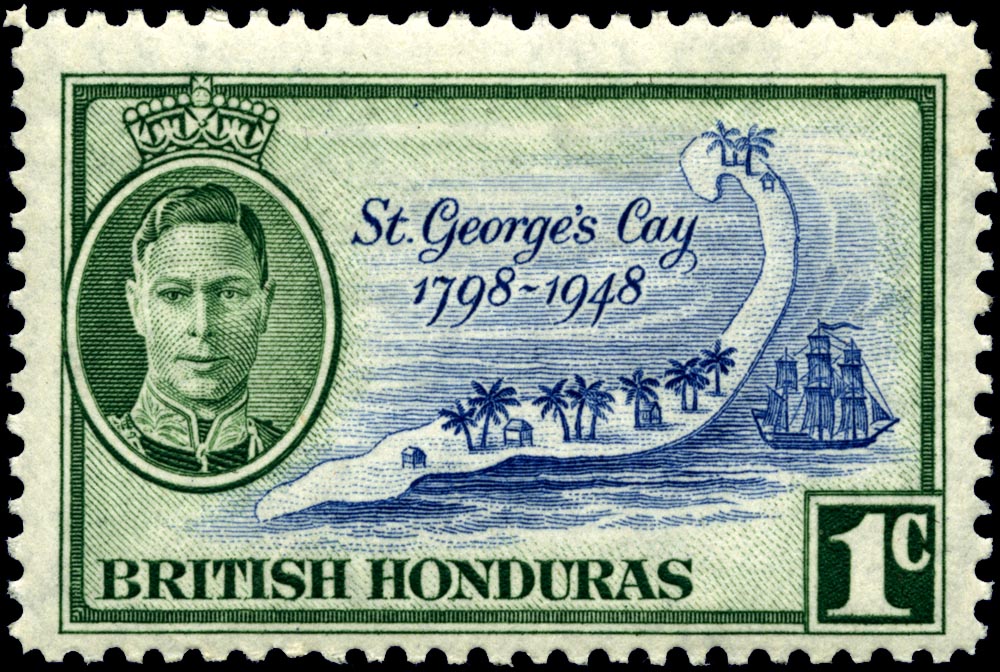
|
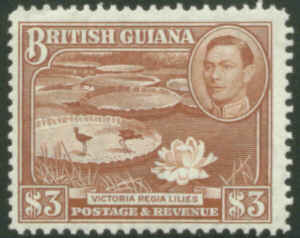
|
|
Deputy Chairman Mark Bailey gave the vote of thanks and congratulated Brian on his perspicacity. We all look forward to the next instalment in a year's time.
|
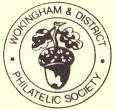











![Cayman Islands War Tax stamps 1½d on 2½d variety missing stop after ‘STAMP’ [R.1/4], SG. 53b. Cayman Islands War Tax stamps 1½d on 2½d variety missing stop after ‘STAMP’ [R.1/4], SG. 53b.](cayman_1917.jpg)













